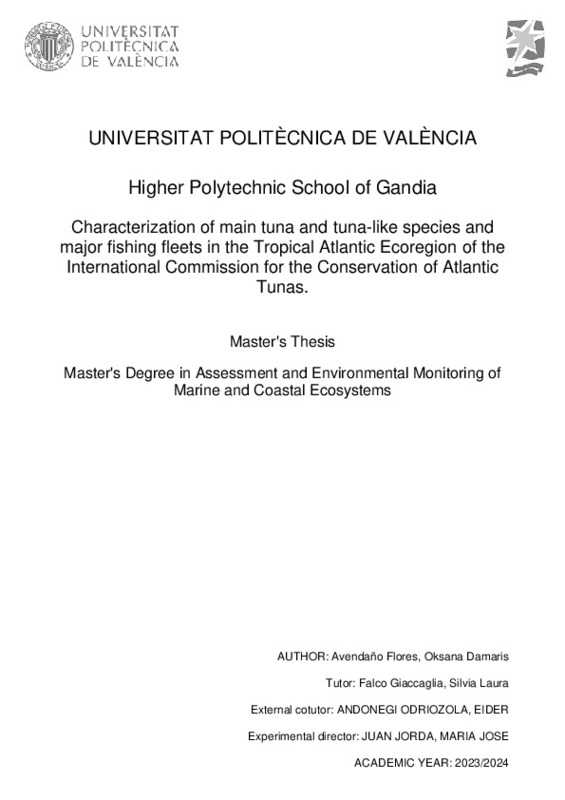|
Resumen:
|
[ES] La implementación del Enfoque Ecosistémico para la Gestión Pesquera (EAFM, de sus siglas en inglés) requiere la identificación de un marco espacial dentro del cual se puedan caracterizar, monitorear e informar sobre ...[+]
[ES] La implementación del Enfoque Ecosistémico para la Gestión Pesquera (EAFM, de sus siglas en inglés) requiere la identificación de un marco espacial dentro del cual se puedan caracterizar, monitorear e informar sobre diferentes ecosistemas. Desde 2019, la Comisión Internacional para la Conservación del Atún del Atlántico (ICCAT) ha estado desarrollando un proceso para avanzar en la identificación de un marco espacial de regiones ecológicamente significativas (ecoregiones) dentro de su área de convención. Actualmente, se han identificado ocho ecoregiones candidatas, pero aún se requiere su validación para asegurar que estas herramientas puedan servir como un marco espacial para respaldar la planificación y priorización de actividades científicas, estimular la investigación ecosistémica y facilitar el desarrollo de productos integrados de asesoramiento basado en ecosistemas para informar las decisiones de gestión pesquera a nivel regional. Para validar estas herramientas, en esta tesis contribuí al desarrollo de un Ecosystem Fisheries Overview (Ecosystem Fisheries Overview EFO, de sus siglas en inglés) piloto para una ecoregión específica, la Ecoregión Tropical del Atlántico (TAE), respondiendo dos preguntas principales: i) ¿Quién está pescando en la TAE? y ii) ¿Qué especies se están capturando en la TAE?
Esto se logró mediante un análisis de indicadores para identificar las pesquerías y flotas principales que operan en la TAE y caracterizar los principales patrones espacio-temporales de sus capturas desde la década de 1950 hasta 2021. Se identificaron un total de 61 flotas principales de cuatro grupos principales de aparejos (cerqueros, palangreros, redes de enmalle y barcos de cebo) que informaron capturas en la ETA. Las flotas principales, según la predominancia de un número sustancial de prevalencia espacial en la ETA, fueron en su mayoría cerqueros industriales (PS_BLZ, PS_EU y PS_PAN) y flotas palangreras (LL_CHN y LL_JPN, LL_KOR), pero también operan en la TAE un número significativo de flotas más costeras de redes de enmalle, barcos de cebo y palangreros. En cuanto a las capturas totales, la flota de Cerco Europeo emergió como la flota principal en la TAE. Históricamente, las flotas que operan en la TAE se han dirigido principalmente a las tres especies tropicales de túnidos. Actualmente, el atún barrilete (SKJ) contribuye con el 53% de la captura total en la región, seguido por el atún aleta amarilla(YFT) (24.7%) y el atún de ojo grande (BET) (11.78%). La captura de túnidos pequeños también ha ido aumentando con el tiempo, contribuyendo actualmente al 5.94% del total de capturas. El estudio proporciona el primer EFO preliminar para una ecorregión de la ICCAT, respaldando la viabilidad de crear productos regionales de asesoramiento ecosistémico para complementar los asesoramientos existentes para especies individuales. Sin embargo, nuestros hallazgos destacan la necesidad de mejorar los informes estadísticos pesqueros con resoluciones espaciales mejoradas a nivel de flota y una representación aumentada de las especies que interactúan con las pesquerías de la CICAA. Esto es crucial para fortalecer el uso de estos productos como base para informar el empleo de EAFM en ICCAT.
[-]
[EN] The implementation of the Ecosystem Approach to Fisheries Management (EAFM) requires the identification of a spatial framework within which different ecosystems can be characterized, monitored, and reported on. Since ...[+]
[EN] The implementation of the Ecosystem Approach to Fisheries Management (EAFM) requires the identification of a spatial framework within which different ecosystems can be characterized, monitored, and reported on. Since 2019, the International Commission for the Conservation of Atlantic Tunas (ICCAT) has been developing a process to advance the identification of a spatial framework of ecologically meaningful regions (ecoregions) within its convention area. Currently, eight candidate ecoregions have been identified, but their validation is still required to ensure that these tools can serve as spatial framework to support the planning and prioritization of scientific activities, stimulate ecosystem research, and facilitate the development of integrated ecosystem-based advice products to inform fisheries management decisions at the regional level. To validate these tools, in this thesis I contributed to the development of a pilot Ecosystem Fishery Overview (EFOs) for one specific ecoregion, the Tropical Atlantic Ecoregion (TAE) by answering two main questions: i) Who is fishing in the TAE? and ii) What species are being caught in the TAE?
This was achieved through an analysis of indicators to identify the core fisheries and fleets operating in the TAE and to characterize the main spatio-temporal patterns of their catches from the 1950s to 2021 A total of 61 core fleets of four major gear groups (purse seiners, long liners, gillnets and bait boats) were identified reporting catches in the TAE. The main fleets based on the dominance of substantial number spatial prevalence in the TAE were largely industrial purse seine (PS_BLZ, PS_EU and PS_PAN) and longline fleets (LL_CHN and LL_JPN, LL_KOR) but a significant number of more coastal artisanal fleets of gillnets, bait boats and long liners also operate in the TAE. In terms of total catches, the European Purse Seine fleet emerged as the primary fleet in the TAE. Historically the fleets operating in the TAE have mostly targeted the three tropical tuna species. Currently, Skipjack tuna contributes 53% of the total catch in the region followed by Yellowfin Tuna (24.7%) and Bigeye Tuna (11.78%). The catch of small tunas has also been increasing over time, currently contributing to 5.94% of total catch. The study provides the first preliminary EFO for an ICCAT ecoregion supporting the feasibility of creating regional ecosystem advice products to complement the existing advice for single species. However, our findings underscore the need for enhanced fisheries statistical reporting with improved spatial resolutions at the fleet level and an increased representation of species interacting with ICCAT fisheries. This is crucial to strengthen the use of these products as a foundation for informing the implementation of the EAFM in ICCAT.
[-]
|





![ZIP archive [ZIP]](/themes/UPV/images/zip.png)


